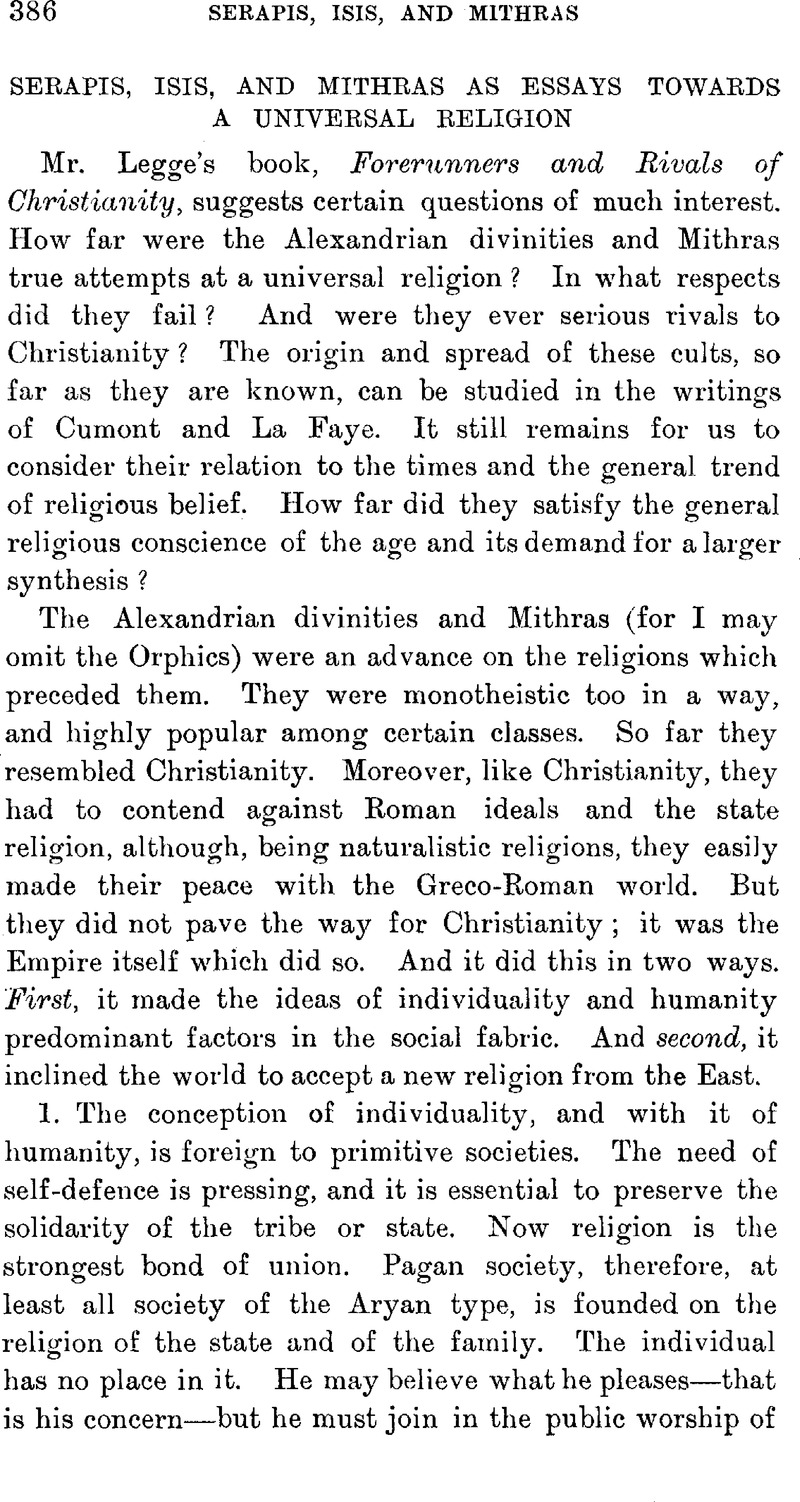No CrossRef data available.
Published online by Cambridge University Press: 15 March 2011

page 387 note 1 Origen c. Cels, . iv, 96Google Scholar, quotes Celsus to the effect that “Many of the animals claim to have ideas of God”, and “the irrational animals are nearer the society of God [than men]”.
page 390 note 1 Pausanias, , iv, 32. 4Google Scholar: γὼ δ χαλδαους κα Ἰνδ![]() ν τοὺς μγους πρώτους ο
ν τοὺς μγους πρώτους ο![]() δα εἰπντας ὡς θνατς στιν νθρώπου ψυχ.
δα εἰπντας ὡς θνατς στιν νθρώπου ψυχ.
page 390 note 2 Origen c. Cels, . i, 2Google Scholar: ἱκανοὺς εὑρε![]() ν δγματα τοὺς βαρβρους, κρ
ν δγματα τοὺς βαρβρους, κρ![]() ναι δε κα βεβαιώσασθαικα σκ
ναι δε κα βεβαιώσασθαικα σκ![]() σαι πρς ρετν τ ὑπ βαοβρων εὑρεθντα μενονς εἰσινἛλληνες.
σαι πρς ρετν τ ὑπ βαοβρων εὑρεθντα μενονς εἰσινἛλληνες.
page 392 note 1 Tertullian, de Baptismo, 5: “Nam et sacrisquibusdam per lavacrum initiantur Isidis alicuius aut Mithrae.” Apuleius, Metamorph, xi, 23, describes the baptismal service of Isis: “Stipatum me religiosa cohorte deducit (sacerdos) ad proximas balneas, et prius sueto lavacro traditum praefatus deum veniam purissime circumrorans abluit.”
page 392 note 2 For the taurobolium and its origin v. Cumont, , Mysteries of Mithra, pp. 180–1Google Scholar. The idea is conveyed in an inscription: “taurobolis criobolioque in aeternum renatus.” But the taurobolium was sometimes repeated after twenty years. The taurobolium had originally been the magical transference of physical energy from the bull to the man; it now conveyed spiritual life.
page 392 note 3 The Isiac novice lived sparingly for ten days, drinking no wine and avoiding all animal food (Apul. Met. xi, 23). The novice of Mithras had to pass through eighty trials, and some of them were said to be terrifying.
page 392 note 4 Tertull. Apol. 39.
page 392 note 5 Justin, M. Apol. i, 66Google Scholar: ἄρτος κα ποτριον ὕδατος τθεται ν τα![]() ς το
ς το![]() μυουμνου τελετα
μυουμνου τελετα![]() ς μετ πιλγων τιν
ς μετ πιλγων τιν![]() ν. Tertullian, de praescript. haeret., c. 40: (Mithra) “celebrat et panis oblationem.”
ν. Tertullian, de praescript. haeret., c. 40: (Mithra) “celebrat et panis oblationem.”
page 392 note 6 Apuleius, , Met. xi, 17Google Scholar. The service concluded with the unintelligible words οια øεσια. A conjectural, but not a probable, emendation which I have somewhere seen is λαο![]() ς ἄøεσις = ite, missa est.
ς ἄøεσις = ite, missa est.
page 392 note 7 Justin, M. Dial. c. Tryph. 70Google Scholar: Δικαιοπρα![]() ας γρ λγους κα παρ᾽ κεινο
ας γρ λγους κα παρ᾽ κεινο![]() ς λγεσθαι τεχνσαντο (Mithrae mysteriorum antistites).
ς λγεσθαι τεχνσαντο (Mithrae mysteriorum antistites).
page 392 note 8 Op. cit. 78, and in various other passages. Cf. Protevangelium Jacobi.
page 393 note 1 Apuleius, , Metamorphoses, xi, 5.Google Scholar
page 397 note 1 Porphyry, , De Abstin. iv, 16.Google Scholar
page 397 note 2 Porphyry, , De Antro Nymph., c. 24Google Scholar: ὡς κα τα![]() ρος ὢν Μθρας, κα γενσεως δεσπτης, κατ τν ἰσημερινν δ ττακται κκλον.
ρος ὢν Μθρας, κα γενσεως δεσπτης, κατ τν ἰσημερινν δ ττακται κκλον.
page 399 note 1 e.g. Clemens Alex, mentions Isis three times and Serapis eight; he quotes the Sibyl's prophecies concerning them; discusses the origin of Serapis; identifies Isis with Ceres; and so forth. As a resident in Alexandria, we should have expected Serapis to bulk largely in his mind; but it is not so.
page 399 note 2 Harnack, , Expansion of Christianity, Eng. tr., ii, p. 450, n. 1.Google Scholar
page 399 note 3 Origen c. Cels, . vi, 22Google Scholar. This chapter and the two following, together with the references of Porphyry and the Mithræum at Ostia, show how very astrological was the cult.
page 399 note 4 e.g. Justin, M. Dial. c. Tryph. c. 78Google Scholar, and Tertullian, de praeser. and elsewhere.
page 399 note 5 Matt, , xxviii, 19.Google Scholar